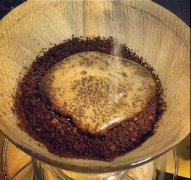Coffee Common sense Coffee Bean Coffee Baking steps Analysis
Once the coffee seed is planted, no one can change its final quality. However, the color, aroma, bioactive components and health characteristics of coffee are related to the roasting process. In the process of roasting, coffee is heated at 190-220 °for 7-20 minutes, which helps to bake out its aroma and good taste. It also helps to form lactone, nicotinic acid, coffee tannic acid with antioxidant effect, caffeine and other health-beneficial compounds and trace elements.

Caffeine is the only substance that remains unchanged throughout the baking process, but huge, complex and not yet fully understood chemical changes in coffee beans cause about 25% of their weight loss. During the baking process, the color of coffee beans changes from green to yellow, then to brown, and finally to brown. The process from yellow to brown is often referred to as the first burst, because a popcorn-like popcorn popping sound occurs at about 160 degrees, when the coffee beans more than double in size, turn light brown, and lose about 5% of their weight. The coffee bean expands to 150% of its original volume, and caramelization begins inside the bean.
Next, the temperature rises from 205 °to about 220 °, the color of the coffee changes from light brown to medium brown, and there is about 15% weightlessness. This chemical process is called high-temperature decomposition, in which the chemical composition of coffee beans changes and releases carbon dioxide. After the first burst, there is a pause, followed by a brief endothermic process, followed by a chemical reaction, followed by an exothermic process known as the second burst. The second high temperature decomposition occurs at 225 °and the color changes to a moderate black-brown color.
Important Notice :
前街咖啡 FrontStreet Coffee has moved to new addredd:
FrontStreet Coffee Address: 315,Donghua East Road,GuangZhou
Tel:020 38364473
- Prev

Four-leaf clover, a necessary plant in a cafe
According to legend, with a pot of four-leaf clover, that is, with happiness, you can make a wish. Give sticky people a pot of four-leaf clover. I hope you can all find your own happiness!
- Next

The basic knowledge of coffee flowers in boutique coffee
It is generally foggy in alpine areas, and sunlight is affected by fog beads, which enhances part of the visible light, thus enhancing the effect of photosynthesis. for the second reason, the forest in the alpine area is luxuriant. under the premise of temperature, rainfall, topography and soil, coffee trees especially like the microclimate characteristics of frequent fog and large temperature difference between day and night. If an area, despite its altitude,
Related
- Beginners will see the "Coffee pull flower" guide!
- What is the difference between ice blog purified milk and ordinary milk coffee?
- Why is the Philippines the largest producer of crops in Liberia?
- For coffee extraction, should the fine powder be retained?
- How does extracted espresso fill pressed powder? How much strength does it take to press the powder?
- How to make jasmine cold extract coffee? Is the jasmine + latte good?
- Will this little toy really make the coffee taste better? How does Lily Drip affect coffee extraction?
- Will the action of slapping the filter cup also affect coffee extraction?
- What's the difference between powder-to-water ratio and powder-to-liquid ratio?
- What is the Ethiopian local species? What does it have to do with Heirloom native species?

